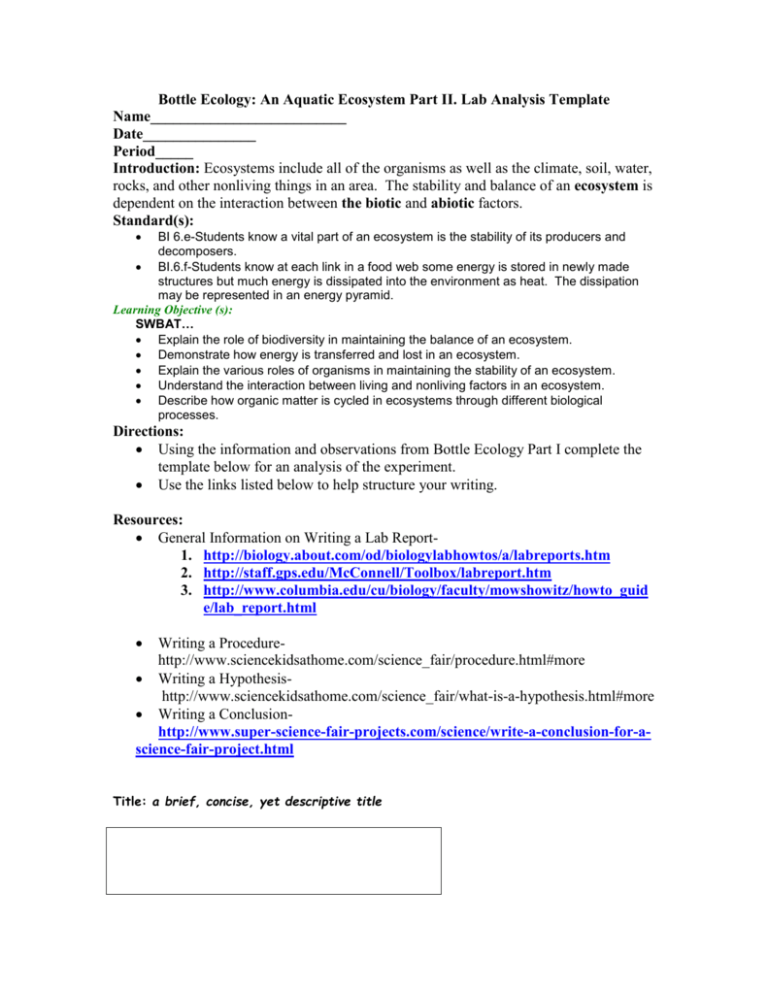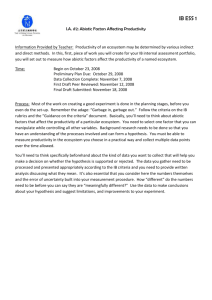Bottle Ecology Part II Lab Analysis Template
advertisement

Bottle Ecology: An Aquatic Ecosystem Part II. Lab Analysis Template Name__________________________ Date_______________ Period_____ Introduction: Ecosystems include all of the organisms as well as the climate, soil, water, rocks, and other nonliving things in an area. The stability and balance of an ecosystem is dependent on the interaction between the biotic and abiotic factors. Standard(s): BI 6.e-Students know a vital part of an ecosystem is the stability of its producers and decomposers. BI.6.f-Students know at each link in a food web some energy is stored in newly made structures but much energy is dissipated into the environment as heat. The dissipation may be represented in an energy pyramid. Learning Objective (s): SWBAT… Explain the role of biodiversity in maintaining the balance of an ecosystem. Demonstrate how energy is transferred and lost in an ecosystem. Explain the various roles of organisms in maintaining the stability of an ecosystem. Understand the interaction between living and nonliving factors in an ecosystem. Describe how organic matter is cycled in ecosystems through different biological processes. Directions: Using the information and observations from Bottle Ecology Part I complete the template below for an analysis of the experiment. Use the links listed below to help structure your writing. Resources: General Information on Writing a Lab Report1. http://biology.about.com/od/biologylabhowtos/a/labreports.htm 2. http://staff.gps.edu/McConnell/Toolbox/labreport.htm 3. http://www.columbia.edu/cu/biology/faculty/mowshowitz/howto_guid e/lab_report.html Writing a Procedurehttp://www.sciencekidsathome.com/science_fair/procedure.html#more Writing a Hypothesishttp://www.sciencekidsathome.com/science_fair/what-is-a-hypothesis.html#more Writing a Conclusionhttp://www.super-science-fair-projects.com/science/write-a-conclusion-for-ascience-fair-project.html Title: a brief, concise, yet descriptive title Introduction: Provide a brief overview of the experiment Describe how ecosystems work (interactions between organisms (biotic) and nonliving (abiotic) factors) Create a food web for the ecosystem. Statement of the Problem: What question(s) are you trying to answer? Hypothesis: (Use if…then statement) Make sure the statement is testable. Make sure your hypothesis is a complete sentence. Materials: Make a list of ALL items used in the lab. This can be a bulleted list. Procedure: (use the information from Part I of the experiment to do this.) Write a paragraph (complete sentences) which explains what you did in the lab. Your procedure should be written so that anyone else could repeat the experiment. Results (Data Analysis): This section should include any data tables, observations, or additional notes you make during the lab. All tables, graphs and charts should be labeled appropriately 100 80 60 East West 40 North 20 0 1st Qtr 2nd Qtr 3rd Qtr 4th Qtr Conclusions: (use complete sentences) Accept or reject your hypothesis. EXPLAIN why you accepted or rejected your hypothesis using data from the lab. Include a summary of the data - averages, highest, lowest..etc to help the reader understand your results List one thing you learned and describe how it applies to a real-life situation. Discuss possible errors that could have occurred in the collection of the data (experimental errors)









